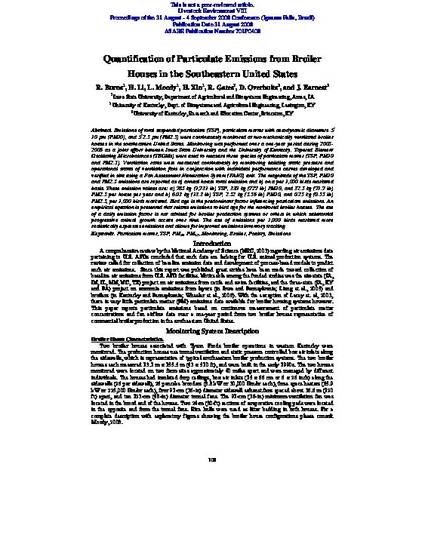
Emissions of total suspended particulate (TSP), particulate matter with aerodynamic diameters = 10 µm (PM10), and = 2.5 µm (PM2.5) were continuously monitored at two mechanically ventilated broiler houses in the southeastern United States. Monitoring was performed over a one-year period during 2005-2006 as a joint effort between Iowa State University and the University of Kentucky. Tapered Element Oscillating Microbalances (TEOMs) were used to measure three species of particulate matter (TSP, PM10 and PM2.5). Ventilation rates were measured continuously by monitoring building static pressure and operational status of ventilation fans in conjunction with individual performance curves developed and verified in situ using a Fan Assessment Numeration System (FANS) unit. The magnitude of the TSP, PM10 and PM2.5 emissions are reported as a) annual house total emission and b) on a per 1,000 birds marketed basis. These emission values are: a) 785 kg (1,731 lb) TSP, 330 kg (727 lb) PM10, and 32.5 kg (71.7 lb) PM2.5 per house per year and b) 6.03 kg (13.3 lb) TSP, 2.52 kg (5.56 lb) PM10, and 0.25 kg (0.55 lb) PM2.5, per 1,000 birds marketed. Bird age is the predominant factor influencing particulate emissions. An empirical equation is presented that relates emissions to bird age for the monitored broiler houses. The use of a daily emission factor is not advised for broiler production systems or others in which substantial progressive animal growth occurs over time. The use of emissions per 1,000 birds marketed more realistically expresses emissions and allows for improved emissions inventory tracking.
Available at: http://works.bepress.com/richard-gates/64/

Livestock Environment VIII, 31 August – 4 September 2008, Iguassu Falls, Brazil 701P0408.